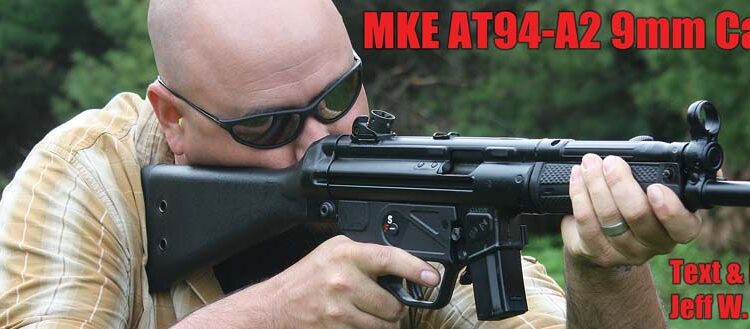By Jeff W. Zimba

We have tested numerous spin-offs of the popular HK rifles and submachine guns over the years and we were excited to try the latest offering from MKE and marketed by American Tactical Imports (ATI): the AT-94A2. While it has the general look, feel and function of the HK94 carbine, there are many internal changes that those at ATI have diligently worked out with BATFE Technology Branch to allow this Turkish manufactured carbine to be importable through the miles of red tape wrapped around the import regulations.
The AT-94A2 is a 9x19mm carbine that resembles the long gone HK94. Our test gun was shipped with an A2 (full length) stock that resembled that of the .223 HK93, which is much thinner in the front than the traditional HK94 and MP5 stock and has a metal section where the stock is pinned to the receiver instead of a large, plastic end that slides over the receiver section. It was confirmed that it is indeed a modified HK93 stock used with this configuration and the reason will be explained a little later in this article.
At first glance, other than the rear stock, nothing was immediately particularly different about the MKE AT-94A2. It was supplied with a slim-line forend and a full 16.25-inch barrel, in order to remain a Title I firearm. While this Turkish-manufactured specimen is not quite as smooth and clean in its lines as its German predecessor, it is still an attractive piece and an excellent alternative for those who want a 9mm semiautomatic carbine in the style of possibly the worlds most popular late generation submachine gun.
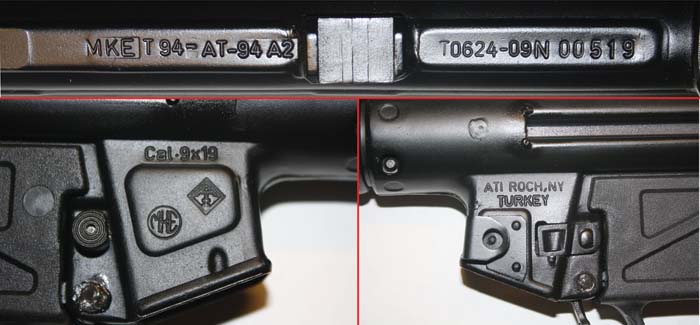
Same Thing, Just Different
Just like the original MP5 submachine gun and its semiautomatic relatives, the AT-94A2 is a closed bolt, 9x19mm, roller delayed blowback action. The chamber is fluted and the barrel is rifled with a 6-groove, 1 turn in 10 inches, right hand twist. The front sight is an enclosed protected post and the rear sight is the customary rotating drum with 4 aperture settings. The operating procedure is identical to the standard German guns.
As previously mentioned, in order to comply with import laws there have been numerous internal changes from the original H&K design in order to comply with 18 U.S.C. 925(d) (see sidebar this article). The most obvious change upon initial examination is the internal dimension of the magazine-well. It will not accept a standard MP5 9mm magazine due to the addition of two rods inside the magazine well that coincide with the slotted magazines available from ATI. Another internal difference is the addition of a block in the rear of the receiver that prevents the installation of a fully automatic bolt carrier. This is not going to be a positive aspect for our registered sear or trigger pack users but was necessary to comply with the import regulations to import the gun in its current, carbine configuration.
The biggest difference is not even noticed until the gun is disassembled – and a big difference it is. As previously mentioned, the stock is a modified HK93 stock and the reason is revealed as soon as the rear takedown pin is removed. The grip portion has been permanently attached to the stock giving a similar appearance to an AR-15/M16 when the receiver is separated for cleaning and maintenance. Because of this non-traditional parts relationship, the assembly after basic fieldstrip is a little tricky but an easy task once studied a little. As are all legal semiautomatic HK type firearms (aside from the very early SF imports) the trigger group is locked on a shelf with no pushpin on the front.
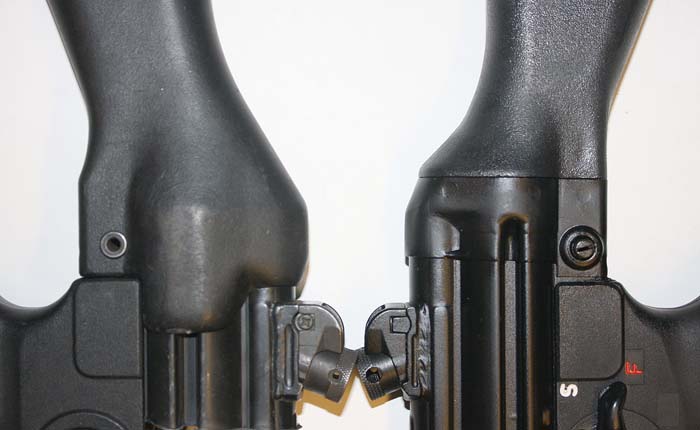
Range Time
The AT-94A2 was test fired at the Small Arms Research facility in Maine over several days. Ammunition used included 115-grain FMJ Wolf Performance Ammunition, Winchester (white box) 115-grain FMJ ammunition and 147-grain Atlanta Arms JHP ammo. All ammunition performed well and we only experienced a single malfunction of any kind during the entire test period. After firing several rounds with no cleaning or maintenance an ejected casing seemed to find a path under the bolt and down into the trigger pack. Upon opening the action and shaking it, it fell out on its own. We could not duplicate the malfunction and have no idea when or how it happened. The feeding was smooth and the ejection was very positive with all ammo. 10-round strings (due to the 10-round capacity of the provided magazines) were fired and all ammo performed quite well. Most of the shooting was completed at 25 yards and 50 yards. Due to the small caliber and open sights it isn’t typically a platform that would be regularly utilized at distances beyond that. Several 10-shot groups averaged 2.14 inches overall and a separate muzzle velocity chart has been included to show the performance from this particular platform.

Conclusions
The time spent with the AT-94A2 was reminiscent of the first few outings, decades ago, with the original HK94s and MP5. Although a little awkward in some of the areas where the changes have been made, the excitement of another variant was still there. The function in every area was not only acceptable, but also actually quite impressive. The mechanism is tight and positive and all aspects were correct. The magazines lock tight, the rounds present themselves correctly, the feed, fire, extraction and ejection are positive and performed without failure except for that one time. The trigger is very smooth, although a little long and the release will even surprise you until you spend a significant amount of time with it. Accuracy exceeded our expectations for a pistol caliber carbine with open sights, regardless of the type used at the time. The oddities encountered with the new AT-94A2, such as the stock/trigger group combo, the magazine and FA bolt block are all too easy to be looked at as negatives from those of us who are sear and registered pack owners. The addition of several U.S. parts or a simple SBR NFA registration may make those concerns a non-issue anyway, but this early in the game we are cautious not to make guesses in such matters. What we do believe with some amount of certainty is that for someone who simply wants a semiautomatic version of the world famous MP5 without breaking the bank on an original, elusive, collectable, German gun, this may be the gun they thought they would never be able to own. When you add in the fact that it runs great and is very comfortable to shoot, with an MSRP of $1,549, it will be a certain reason to celebrate. For more information on the AT-94A2 and the rest of the ATI lineup, please visit them on line at www.americantactical.us.

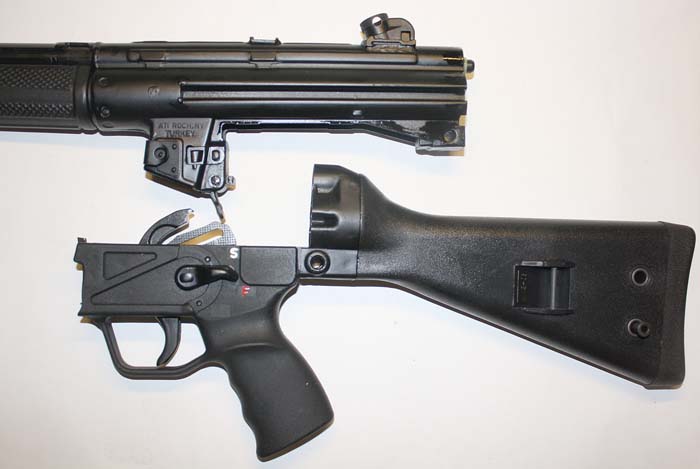
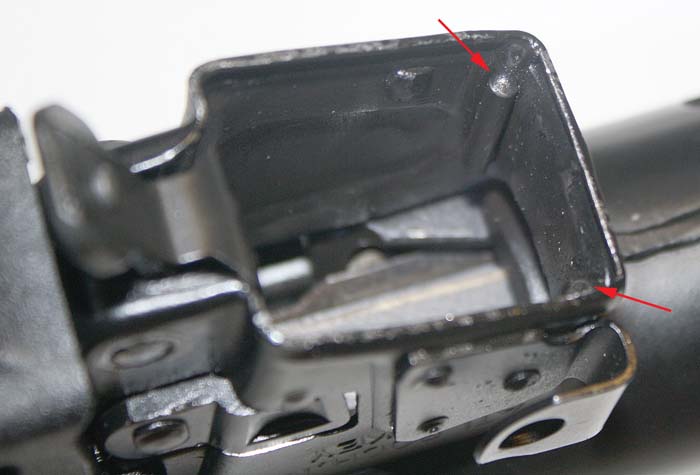
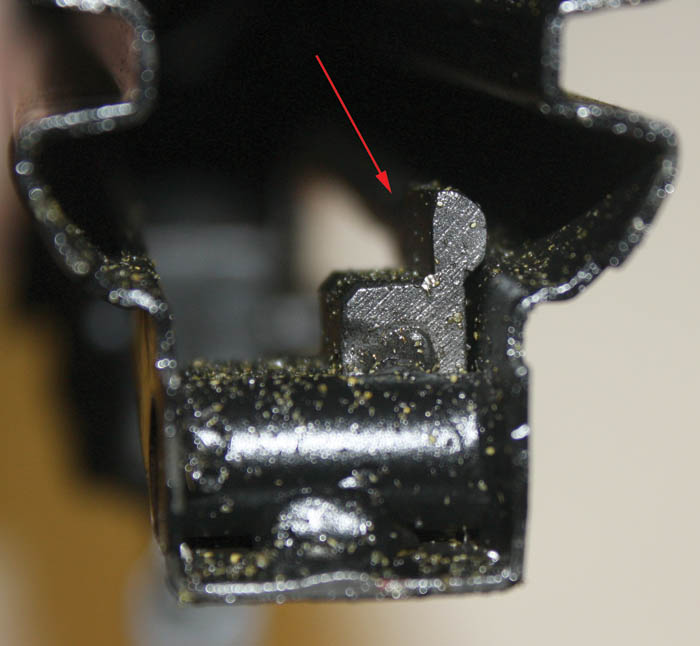

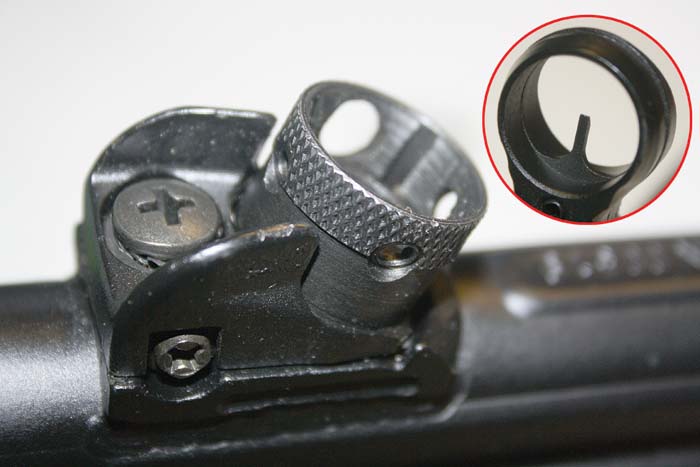
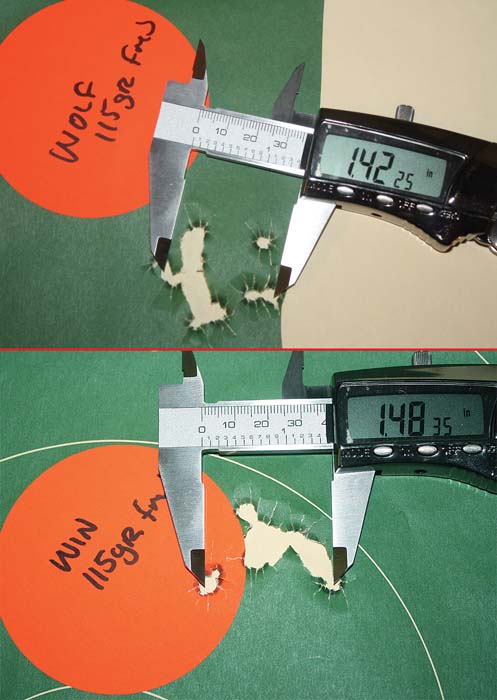
Sources
American Tactical Imports
(800) 290-0065
AcuSport Corporation
(937) 593-7010
Amchar Wholesale, Inc.
(800) 333-0695
Importation / Manufacturing Red Tape Revealed
Due to the regulations in 18 U.S.C. 925(d) and 922(r), it is extremely difficult for many popular firearms to be imported or manufactured domestically from imported parts if they do not meet certain “Sporting Purpose” criteria. This has been difficult to completely understand and follow since its inception and remains confusing today. Some firearms are defined by make and model, and others by characteristics, and this has led to the higher prices and lower quantities of these guns available today.
Though scrutinized since 1986, guns that were civilian-style semiautomatic variants of foreign machine guns were redesigned to meet the United States regulations and generally treated as any other semiautomatic firearm for purposes of importation. In 1989 ATF (now BATFE) created a new class of firearm known as “Semiautomatic Assault Rifles” and a new criteria followed (18 U.S.C. 925(d)) to qualify (or disqualify) all semiautomatic firearms before importation would be approved. This is where the real confusion started. With many foreign manufacturers unwilling to retool their product lines only for the civilian market of a single country, most imports of many popular and common firearms ceased very quickly. Without listing multiple pages of specific models and manufacturers, the basic disqualifiers (listed directly from the BATFE website) are as follows:
…ATF’s finding was based, in part, on the determination that these rifles have certain characteristics that are common to modern military assault rifles and that distinguish them from traditional sporting rifles. These characteristics include the ability to accept a detachable magazine, folding/telescoping stocks, separate pistol grips, ability to accept a bayonet, flash suppressors, bipods, grenade launchers, and night sights. It was decided that any of these military features, other than the ability to accept a detachable magazine, would make a semiautomatic assault rifle not importable…
After the 1989 decision, many semiautomatic firearms that failed the initial sporting purpose test were simply modified of their disqualifying characteristics, other than the ability to accept a detachable magazine and were allowed to be imported as long as not specifically named on the list of unimportable firearms. This was the period we saw many new model designations imported in different, neutered configurations. In 1997 under the direction of the President and the Secretary of the Treasury ordered a new review of the imported versions and expanded the list to include even more firearms, including these new, currently compliant models which took effect in April of 1998.
Immediately after the original 1989 importation ban it was not uncommon for the new guns to be “remanufactured” domestically to bring them back to their original configuration since it was an importation ruling and did not cover firearms manufactured domestically. This is where 18 U.S.C. 922(r) comes into play, making it illegal to reassemble or remanufacture an imported firearm in an unimportable configuration if the firearm still used too many foreign parts in the end product. This is where the parts list came from and spurred the domestic manufacture of numerous parts that used to be commonly imported. Relating to the assembly of “nonsporting firearms”, 922(r) is as follows:
Section 922(r), Title 18, U.S.C., makes it unlawful for any person to assemble from imported parts any semiautomatic rifle or any shotgun, which is identical to any rifle, or shotgun prohibited from importation under section 925(d)(3) of the GCA. Regulations implementing the law in 27 C.F.R. 478.39 provide that a violation of section 922(r) will result if a semiautomatic rifle or shotgun is assembled with more than 10 of the following imported parts:
- Frames, receivers, receiver castings, forgings, or stampings
- Barrels
- Barrel extensions
- Mounting blocks (trunnion)
- Muzzle attachments
- Bolts
- Bolt carriers
- Operating rods
- Gas pistons
- Trigger housings
- Triggers
- Hammers
- Sears
- Disconnectors
- Buttstocks
- Pistol grips
- Forearms, handguards
- Magazine bodies
- Followers
- Floorplates
| This article first appeared in Small Arms Review V13N11 (August 2010) |



